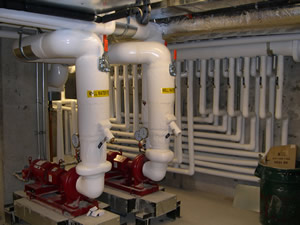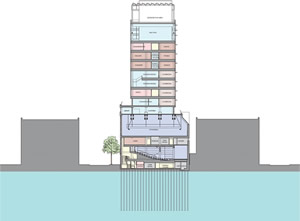A Whole Systems Approach to Sustainability

PHOTOS COURTESY OF ROBERT MINTZES
At the Hackley School in Tarrytown,
New York, a 1903 stone
building was reconstructed.
Heating and cooling is done by
a geothermal system, drilled into
bedrock. The transformed and
expanded building, which has
doubled in size, uses approximately
10 to 15 percent of the energy
of the original building.
Sustainability is an ecological term that has become commonplace
in our vocabulary. We understand that various natural ecosystems,
when left in their natural state, are self-sustaining. In this context, self-sustaining
means that plants and animals and the climate are in balance,
and that the same environment will evolve and sustain itself over many
years, as long as there is no major intervention by an outside force.
When we refer to sustainability
in an academic setting, we are
talking about an environmental
system in which a building or a
campus can sustain itself. What
does this mean? This article will
address four types of sustainability
that can apply to academic
buildings and campuses.
- Environmental sustainability is
the classification that most mimics
nature. By reducing carbon
emissions through renewable fuel
sources, we can reduce environmental
degradation; by planting
campuses with native trees,
shrubs, groundcover, and grasses,
we can reduce the use of fertilizers
and pesticides that pollute our
streams and watersheds.
- In an academic setting, economic
sustainability identifies the strategies
that use resources in a manner
that allows the institution to continue
to function responsibly and
productively over a long period.
- Operational sustainability seeks
to reduce environmental impact,
lower operating costs and increase
workplace safety.
- Student activism refers to the
power that students have to
influence change. Student awareness
of environmental issues can
impact the present generation
and generations to come.
Let us look carefully at these four
approaches to sustainability in academic
settings.

PHOTOS COURTESY OF ROBERT MINTZES
Trevor Day School in New York City is linked
to the subsurface in an unusual way. Three
hundred sixty poured concrete “energy piles”
support the building and are the backbone of
a geothermal system that heats and cools this
new school. The system will be enhanced in the
future by solar collectors mounted above the
rooftop playground.
ENVIRONMENTAL SUSTAINABILITY
MIMICS NATURE
When we speak of environmental
sustainability, we could be referring to one
small parcel of land, or to a large segment
of the natural environment, such as the watershed
associated with a major river. For
example, we might consider the environmental
sustainability of the Hudson River
Valley or the Delaware River Valley. On the
other hand, environmental sustainability
might be limited to the environment of a
single academic building or an academic
campus (the landscape and the buildings).
Academic buildings, especially those
that are situated on campuses, have the potential
to be self-sustaining to a significant
extent, or even completely self-sustaining.
Buildings consume energy, but we can
collect and use energy that is available
from the sun, from the movement of water
or wind, and from geothermal sources. In
essence, we are looking at heating, cooling,
and providing electricity for a campus. It
is possible to produce onsite all the energy
that the buildings will consume. We could
then say that these buildings are environmentally self-sustaining.
Sustainable buildings are constructed
with regionally available natural materials
that are not harmful to the buildings’ occupants.
Building codes have been evolving
toward prohibiting the use of materials
that can be dangerous to the occupants.
ENVIRONMENTAL SUSTAINABILITY
Also refers to outdoor space —
the campus on which the buildings
are situated. The guiding principle is
that the academic landscape should
resemble the natural landscape to the
greatest possible extent. Obviously,
parking lots and playing fields are never
going to be natural landscapes, but it is
possible to mitigate the negative effects
of these components. Parking lots can
be designed with no runoff from their
surfaces, and stormwater can be filtered,
detained and gradually reintroduced
into the soil. Playing fields can be
designed with no negative stormwater
consequences. The challenge comes from
the use of chemical fertilizers or possibly
from the negative aspects of synthetic
turf. Some building codes are addressing
these issues by prohibiting stormwater
runoff from the site, and requiring the
planting of natural vegetation.
In the broader view of the campus
landscape, the resemblance to nature can
be quantified and measured in terms of
stormwater effects and in terms of the
amount of photosynthesis that occurs. The
campus resembles a suburban landscape,
and most suburban landscapes can be
designed to mimic the natural landscape.
ECONOMIC SUSTAINABILITY
VS. THE NATURAL ENVIRONMENT
Economic sustainability is a term that entered the lexicon in
1987 with the publication of the Brundtland Report, from the United
Nations World Commission on Environment and Development.
The report attempts to marry two disparate ideas: sustainability
that is patterned after nature, and the exchange of goods and
services that foster economic development. As countries continue
to advance economically, they strain the ability of the natural environment
to absorb the negative impacts of this economic growth.
Economic sustainability imagines a future in which the economies
of the world can continue to grow without adversely affecting the
natural environment. This may be difficult to accomplish.
When we consider the idea of economic sustainability in terms
of an academic institution, we tend to think of the sources of funds
that support the academic endeavor. A public school might receive
money from taxpayers and, with that money, the school would
maintain its buildings and sites, pay the staff, and purchase fuel
and electricity.
It would be in the interest of such an institution to invest in
simple initiatives, such as insulating the building and using low-energy
lighting to save energy and reduce its carbon footprint. These
institutions are at the smaller end. At the larger end are private
institutions with the endowments and tuitions that help them thrive.
They should invest in high efficiency building envelopes, geothermal
heating and cooling, solar collectors, wind turbines and other
sustainable initiatives that reduce environmental impact.
OPERATIONAL SUSTAINABILITY RELATES TO EFFICIENCY
Operational sustainability in an academic setting can apply to a
single building or a series of buildings on a campus. The issue at hand
is how the sites and buildings can be operated in the most efficient
manner possible. On the energy front, the ultimate goal is to not purchase
energy from the utility companies. Electricity can be produced
on campus through solar collectors and windmills; in addition, significant
amounts of energy can be saved by harnessing the latent heat
and coolness of the ground to help heat and cool the buildings.
The pathway to operational sustainability is relatively straightforward,
but will require time and significant investments. By
implementing the following key points among other strategies,
zero energy buildings and campuses are possible.
- Assess current energy utilization and set phased goals for reduction.
- Employ alternative strategies, such as solar power, wind power,
and geothermal systems.
- Design building mechanical systems so that buildings hibernate
and use little energy while they are not occupied. (Most academic
buildings are in use only 40 to 50 hours a week, but the buildings
are heated and cooled 168 hours a week.)
- Introduce fresh air into spaces only when they are occupied.
- Switch to low-energy lighting.
- Use effective mechanical system controls to reduce
energy consumption.
- Find ways to use less water.
- Reduce the workload for the maintenance staff by keeping
the landscape more natural.
- Develop a plan to reduce energy consumption, and update
it frequently.
STUDENT ACTIVISM CALLS FOR
STEWARDSHIP OF THE ENVIRONMENT
Student activism relates to what students and staff might be
able to learn by observing and monitoring how a sustainable
building and a sustainable campus function. The negative human
influence on the natural environment has grown geometrically in
only the last couple of centuries. It seems there are no limits to the
size and destructiveness of the human population. We have recognized,
belatedly, that environmental stewardship is a critical issue.
Student activism related to environmental stewardship can be
effective only if students have been educated about these issues.
They could urge the institution to make more rapid progress if they
understood the long-term benefits of sustainability. A building or a campus can be a learning tool for students
if there are measureable results that can be
observed and improved.
The challenge for this generation of
students is how to work for the sustainability
of the planet. Perhaps good places
to start are in their own school buildings
and school communities. The buildings
and campuses could be learning tools that
deepen their understanding of these world-threatening
issues, and inspire the changes
that are necessary.
SUSTAINABLE REMEDIES
ARE WITHIN REACH
Sustainability is a multifaceted subject.
It is not surprising that the idea is difficult
to define and understand. Nevertheless,
the players within the education community
have the opportunity to influence the
sustainability of their physical settings. If
they collaborate effectively, we could see
significant change and improvement.
Sustainable remedies are within reach,
but disagreement about the metrics continues
to be a stumbling block. For example,
it is common practice for an academic
institution to construct a new “low energy”
building. The new building uses less energy
per square foot than a typical building, but
is still, in total, adding energy consumption
to the institution. Instead of constructing a
new energy-efficient building, why not modify
an existing building so that it becomes
energy efficient? Or, instead of calculating
energy use per building, why not calculate
energy use per student? These debates might
stimulate discussions of environmental
awareness at academic institutions.
If you imagine that all the environmental
damage is recent, I remind you that our forebears
2,000 years ago were raising similar
issues. The Roman essayist Pliny the Elder
(23 to 79 AD) bemoaned the destructive
influence that human beings have on the natural
environment. In his Naturalis Historia,
one of the first naturalist encyclopedias, he
wrote, “…in regard to nature’s elements, we
have no gratitude… She is flung into the sea
or dug away to allow us to let in the channels.
Water, iron, wood, fire, stone, growing crops
are employed to torture her at all hours,
and much more to make her minister to our
luxuries and our sustenance.”
Pliny was worried when the world population
was only 300 million. Never could he
have imagined the danger we face now.
This article originally appeared in the issue of .